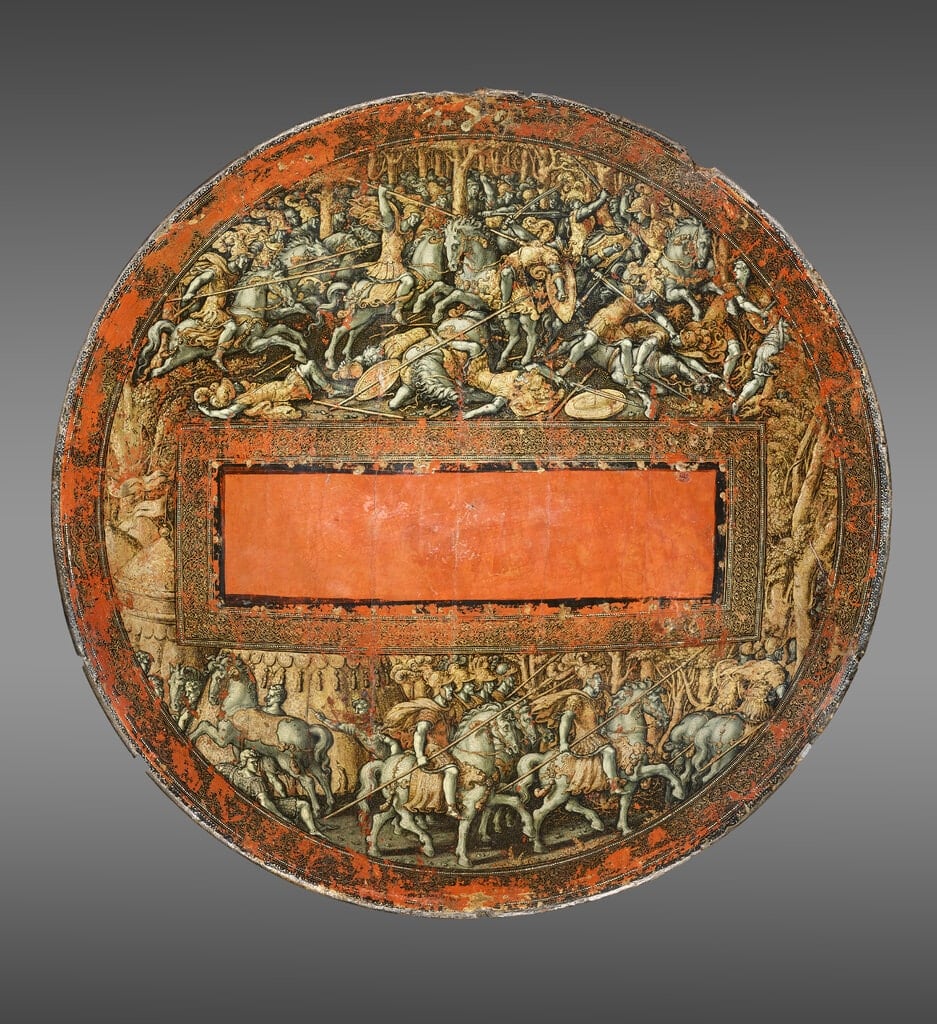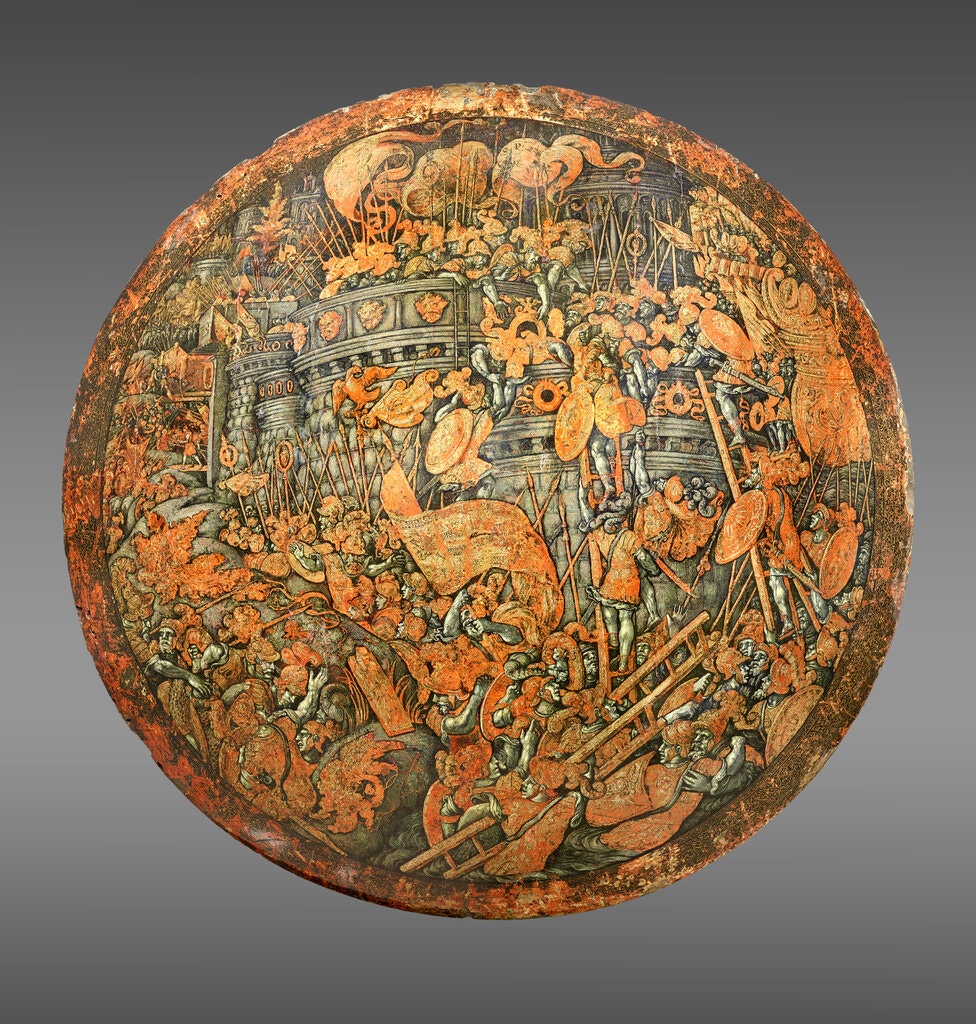
A rare Renaissance shield from the collection of Franz Ferdinand returned to the Czech Republic
Categories: Nálezy nejenom s detektorem kovů v USA, severní a jižní Americe
The Philadelphia Museum of Art and the National Historic Preservation Institute have jointly announced an agreement to return to the Czech Republic a unique Italian shield of incalculable value from the workshop of Girolamo di Tommaso da Treviso (1497 - 1544). Missing after the war, it was recently found in the armour and weapons galleries as part of the Carl Otto Kretzschmar von Kienbusch Museum Collection in Philadelphia, where it has been on display since 1976.
The elaborate painted decoration of the shield is attributed to Girolamo di Tommaso da Treviso after a design by the painter Giulio Romano 1492 / 99 - 1546). The shield was made in about 1535 of wood, linen, gesso, gold and pigment and is about 60 cm in diameter. The scene on its outer side depicts the attack on New Carthage (209 BC) and the great victory of the Roman general Publius Cornelius Scipio (237 - 183 BC).
The decoration suggests a historical parallel between Scipio's military successes, many of which took place in Africa, and the victory of the Holy Roman Emperor Charles V.(1519-1556), who was returning from a successful military campaign against Muslim pirates in North Africa in 1535. The shield was probably part of one of the ceremonies held throughout Italy to welcome Emperor Charles V in triumph.
The shield was originally part of the collections of Archduke Franz Ferdinand (full name Franz Ferdinand Karl Louis Joseph Maria Archduke of Austria-Este) whose assassination in 1914 virtually triggered the 1st Austrian Empire. World War I. The Archduke owned one of the most important European collections of arms and armour, which was exhibited at Konopiště.
When the former Habsburg estates were redistributed after the war, the castle and its collections became the property of the government of the newly formed Czechoslovakia in 1919. In 1943, the German army moved the collection, including the shield, from the castle to Prague to become part of the newly established Adolf Hitler Military Museum.
However, the curator of arms and armour, Leopold Ruprecht, inventoried the collection and subsequently sent it to Vienna for the planned huge Hitler Museum in Linz, Austria. At the end of the war, the collection was acquired by the Allies and a large part of it was returned to the Czechoslovak authorities in 1946. But the shield, along with 14 other objects, was nowhere to be found, and was not discovered until 1976, when the Philadelphia Museum acquired it from Carl Otto Kretzschmar von Kienbusch. There it was still listed as an unknown work until Czech historians identified it in recent years.
Since 2016, there has been lively communication between historians in the Czech Republic and the Philadelphia Museum. Recent research has uncovered pre-World War II inventories that, along with a 1913 photograph, conclusively identify the shield. Based on the new findings, the Board of Trustees of the Philadelphia Museum of Art unanimously concludedthat the work rightfully belongs to the Czech Republic and subsequently approved its return.
The CEO of the Philadelphia Museum of Art, Timothy Rub, and the director of the Czech National Heritage Institute, Naděžda Goryczková, jointly announced the agreement in Philadelphia a few days ago. This confirmed another step in the good cooperation that has accompanied all the discussions between the museum and the Czech Republic and resulted in a mutually satisfactory solution.
"Together with our friends at the National Heritage Institute, the Ministry of Culture and the Ministry of Foreign Affairs of the Czech Republic, we are pleased to announce the end of this investigation. The work, which was lost during the turmoil of World War II, is happily restituted and wound upc an extraordinary partnership has been forged," said Timothy Rub, CEO of the Philadelphia Museum of Art.
"The Philadelphia Museum of Art deserves enormous credit for being willing to return this extremely valuable work of art to the Czech Republic. This event is a prime example of best practices in restitution. Our fruitful cooperation can serve as a model for international partnership in the return of looted art," announced Hynek Kmoníček, Ambassador of the Czech Republic to the United States.
"We sincerely hope that the return of the Renaissance shield to the Czech Republic will mark the beginning of a fruitful collaboration between the Philadelphia Museum of Art and the Nationalm Heritage Institute in the field of restoration, conservation and presentation of works of art," said Naděžda Goryczková, Director of the National Heritage Institute.
"After eight decades, the shield is finally coming home. Justice prevailed over the despotism of the Nazi regime, which illegally stole this precious artifact from the early 16th century. My special thanks to Mr. Timothy Rube and the Board of Trustees of the Philadelphia Museum of Art and Czech institutions: The National Heritage Institute, the Ministry of Foreign Affairs of the Czech Republic and the Embassy of the Czech Republic. Republic in Washington, DC for their extraordinary work and great commitment," said Czech Culture Minister Lubomír Zaorálek,
As part of the agreement, the Czech Republic has graciously agreed to consider any future requests to borrow the shield from the museum. Since 21 September, the shield can be seen in the exhibition of the Konopiště Castle in the showcase of the castle armoury.
Roman Němec



Sources: dailysabah.com, artnews.com, press.philamuseum.org
The article is included in categories:
- Archive of articles > Archaeology > Finds and rescue research abroad > Nálezy nejenom s detektorem kovů v USA, severní a jižní Americe
Post
Jo, tohle je velká paráda. Zrovna před pár dny byla na ČT o štítu reportáž.
Je to super věc, že došlo k předání do ČR.
Skvělá zpráva 
Moc krásný štít! Vítej opět v Čechách!
Asi válečná kořist amíků.
Štít je parádní a jeho příběh s dobrým koncem také 
Je super, že se povedlo jej najít, identifikovat a vrátit zpět. Pěkný článek s dobrým koncem. 















